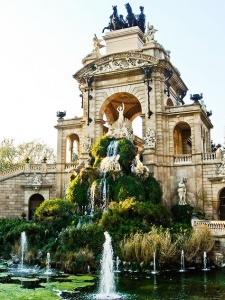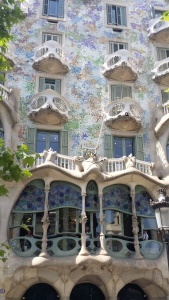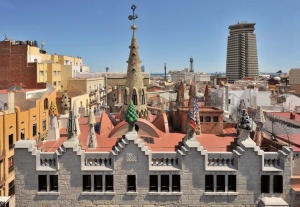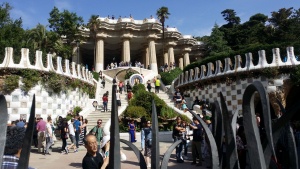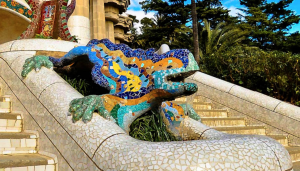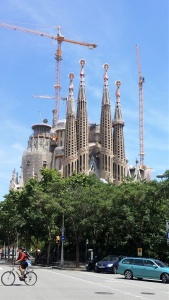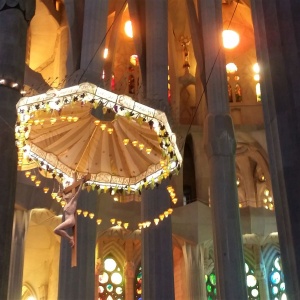Dour and guarded Antoni Gaudi shunned public life, an aesthete who found inspiration in nature and music. Unlucky in love, he was wedded to the austerity of the Spanish Catholic Church where he found solace devoting his artistic life to the glory of God.
Driven by a burning passion, armed with a multi-fold paper tourist map heavily marked with eight locations of Gaudi’s audacious architectural masterpieces, I have sent myself on a treasure hunt with four days roaming Barcelona’s streets to discover every one of them. Gaudi’s Barcelona is the chocolate shop I have waited years to be let loose inside.
DAY 1: Casa Mila, Fountain at Parc de la Ciutadella and, a bonus surprise.
Early summer is grand walking weather in Barcelona. I can feel the city, its pulse, its heartbeat. Catalan spirit fuels the city where sights, sounds, smells excite my wilful spirit. I touch stone walls, trace the patterns on brick pavements, run my hands along decorative cast iron railings. Wide avenues correlate accurately with the grid of my street map. This has not always been my experience. In the distance, reaching high above lush greenery, I catch my first glimpse of the spires of Sagrada Familia. My step falters. With a propensity for unrestrained and uncensored outbursts the reaction of those I share the footpath with suggest I have also given a wild shout of delight.
Surprisingly, Sagrada Familia is not the target for today. First to Passeig de Gràcia one of Barcelona’s most salubrious avenues is the apartment block Casa Mila. In reference to the unconventional rough-hewn appearance it is also known as La Pedrera after the stone quarry in Catalan. Gaudi courted controversy as the organic lines of the building sprouted from the ground. Argument ensued between city council bureaucrats as the structure breached building codes. Gaudi’s relationship frayed with Pere Mila, whose name and money ensured the construction, as the budget skyrocketed. La Pedrera became the object of public mockery and ridicule. A satirical cartoon from the period suggests the building’s true function is to be a garage for zeppelins. Gaudi held firm and won all battles.
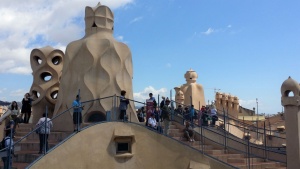 Bypassing the stairs to avoid a repeat of the experience climbing the tiny circular stairwell inside Sacre-Coeur, the elevator provided the swift alternative to access the 8th floor rooftop terrace. The Gaudi designed open-air rooftop terrace replete with undulating floors, stairs that rise and fall, chimneys, ventilation towers, and stairwells that bend and twist creating an unearthly forest of sculptural forms with not a symmetrical line in sight to gain balance. Having barely traversed a third of the roof my ducking and weaving caused concern, from behind friendly voices asked if I required assistance. Without making humiliation too obvious the couple walked either side guiding me around the perimeter leaving with a cautionary note to at all cost avoid the Sagrada Familia towers.
Bypassing the stairs to avoid a repeat of the experience climbing the tiny circular stairwell inside Sacre-Coeur, the elevator provided the swift alternative to access the 8th floor rooftop terrace. The Gaudi designed open-air rooftop terrace replete with undulating floors, stairs that rise and fall, chimneys, ventilation towers, and stairwells that bend and twist creating an unearthly forest of sculptural forms with not a symmetrical line in sight to gain balance. Having barely traversed a third of the roof my ducking and weaving caused concern, from behind friendly voices asked if I required assistance. Without making humiliation too obvious the couple walked either side guiding me around the perimeter leaving with a cautionary note to at all cost avoid the Sagrada Familia towers.
Once inside inspecting the apartments on view reveal Gaudi’s public design for living approximates his personal interior life; functional, restrained, precise, intricately detailed, unfussy, fluid, elegant, organic and, divinely inspired.
Spilling back into the street after three hours of induction and initiation at the hands of the master left me quaking with delight. The paper map indicates a three kilometre walk to the fountain at Parc de la Ciutadella. The fountain worked on by Gaudi as a twenty-five-year-old architecture student is a confection considered worth a look. Interest waned after forty minutes with no sign of the place. I was however, in the Gothic Quarter catching a welcome breeze off the Mediterranean Sea. Taking a moment to re-group, consider options and directions, I sat leaning back against a streetlamp. Looking up at the six ornate lamps it was evident from the decorative iron work it was one of Gaudi’s. A sign from above? I had drawn a bonus extra. Turns out the fountain was close and worth retracing steps to locate.
DAY 2: Casa Batllo, Guell Palace
Casa Batllo embodies imagination and ingenuity creating a house where rigorous constructive functionalism underpins in-depth knowledge of the laws of nature unrestrained from architectural and academic influences, unphased by critics or public criticism. As an unabashed display of Gaudi’s artistic maturity, it is easy to be swept up in the grandeur bedazzled by the splendour of the finished project overlooking the detail in his achievement of innovative architectural design.
Drawing freely from the Catalonian natural environment the façade and internal public spaces are laden with religious and mythological symbolism. Ceramic tiles are used on the façade creating the appearance of a riverbed, top to bottom the internal stairwell utilises descending shades of blue, deep to pale, to better distribute the spill of light. The roof tiles have been likened to that of a dragon’s scales from which extend the hilt of St George’s sword. St George being the patron saint of Catalonia. In a show of devotion to the Catholic Church the outer wall displays the monograms of Jesus, Mary, and Joseph. Hours can be spent seeking out the hidden meanings integrated inside and out. Two and half hours later, awestruck and overwhelmed, I need oxygen and Guell Palace still waits at number five Carrer Nou de la Rambla.
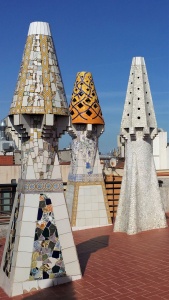 Faced with a small plot on a narrow street in a bad part of town Gaudi, now aged 34, is commissioned by the wealthy industrialist Eusebi Guell, to design a residential palace to host social gatherings for the Catalan upper class. Initially the street frontage appears restrained, imposing, severe, until the two magisterial wrought iron entrance gates take your eye revealing the undeniable stamp of Gaudi. Step inside and a new world awaits. A vestibule split in two by a staircase rising to the main floor, a central hall opens upwards three floors topped by a cupola detailed in both classical and Islamic style. Judicious use of space designed upwards off the central hall has family quarters, guest rooms and servants’ quarters cunningly shielded from public gaze. Two significant architectural innovations also contribute to the unique structure. The basement becomes the carriage room, a huge expanse of mushroom topped brick pillars to support the entire structure, the rooftop the palace’s most evocative space. Twenty brick chimneys covered in trencadis ceramic work, glass, marble, porcelain or sandstone, four skylights in an arch shape surround a narrow lantern dome rising fifteen metres above roof level with a radiant sun, a bat weather vane, and Greek cross pre-dates La Pedrada by two decades.
Faced with a small plot on a narrow street in a bad part of town Gaudi, now aged 34, is commissioned by the wealthy industrialist Eusebi Guell, to design a residential palace to host social gatherings for the Catalan upper class. Initially the street frontage appears restrained, imposing, severe, until the two magisterial wrought iron entrance gates take your eye revealing the undeniable stamp of Gaudi. Step inside and a new world awaits. A vestibule split in two by a staircase rising to the main floor, a central hall opens upwards three floors topped by a cupola detailed in both classical and Islamic style. Judicious use of space designed upwards off the central hall has family quarters, guest rooms and servants’ quarters cunningly shielded from public gaze. Two significant architectural innovations also contribute to the unique structure. The basement becomes the carriage room, a huge expanse of mushroom topped brick pillars to support the entire structure, the rooftop the palace’s most evocative space. Twenty brick chimneys covered in trencadis ceramic work, glass, marble, porcelain or sandstone, four skylights in an arch shape surround a narrow lantern dome rising fifteen metres above roof level with a radiant sun, a bat weather vane, and Greek cross pre-dates La Pedrada by two decades.
Day 3: Park Guell, Gaudi House Museum, Casa Vicens
It had to happen. After two days the Gaudi balloon didn’t burst so much as develop a slow leak. In print finding Park Guell is easily navigable; a public park located on Carmel Hill on the northern face of Collserola mountain range. Then follows the worst directions anyone can give; “you can’t miss it.” Yes, you can, multiple times.
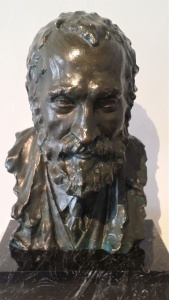 Finally fronting the closed and guarded gates comes the expectation you have pre-booked online to gain entry. Didn’t, so couldn’t, no matter how I persuaded and cajoled. Grumpily I trudged further up the hill to Gaudi House Museum where entry is purchased on the spot. Tucked among trees the house is simple and unadorned this is where his creations found their beginnings. Uncluttered and functional there is no hint of his ghost inhabiting the space unlike Charles Dickens’ house in London laden with spirit you expect to come face to face any tick of the clock. The gift here is the allure of walking in his footsteps, breathing his air.
Finally fronting the closed and guarded gates comes the expectation you have pre-booked online to gain entry. Didn’t, so couldn’t, no matter how I persuaded and cajoled. Grumpily I trudged further up the hill to Gaudi House Museum where entry is purchased on the spot. Tucked among trees the house is simple and unadorned this is where his creations found their beginnings. Uncluttered and functional there is no hint of his ghost inhabiting the space unlike Charles Dickens’ house in London laden with spirit you expect to come face to face any tick of the clock. The gift here is the allure of walking in his footsteps, breathing his air.
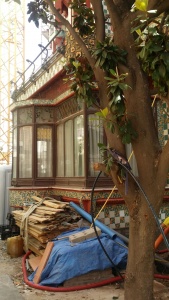 Winding back down the hill through a maze of steep narrow streets to Casa Vicens, Gaudi’s first house, my enthusiasm is short lived. Closed for renovation. Climbing an adjoining fence onto a wall, I call to the workmen hoping for a quick look inside. They do not fall for my charm and shout at me for poking my nose into their yard.
Winding back down the hill through a maze of steep narrow streets to Casa Vicens, Gaudi’s first house, my enthusiasm is short lived. Closed for renovation. Climbing an adjoining fence onto a wall, I call to the workmen hoping for a quick look inside. They do not fall for my charm and shout at me for poking my nose into their yard.
Deflated I take a new direction, the Gothic masterpiece Barcelona Cathedral in the centre of town. The cathedral houses the body of Saint Eulalia entombed in the cathedral’s crypt. Eulalia, a young virgin, spoke out against the Romans. In retribution they exposed her naked in the public square whereupon, in mid-spring, a miraculous snowfall covered her nudity. The enraged Romans put her into a barrel with shards of glass and rolled it down a street. You can count on Catholics to have a good story.
To complete the day, I fell upon La Rambla’s fresh food market and spent many Euros devouring tapas.
Day 4: La Sagrada Familia
The imposing Sagrada Familia, a legacy that draws breathless admiration for the Master of Architectural wonders began work here in 1883 until 1926, when, aged 73 Gaudi met his untimely death. Still unfinished, and forecast for completion in 2026, the scale and scope of his visionary design emblazons the Barcelona skyline.
I can’t remember when I first became aware of Gaudi, I can say this is the structure that fired my passion to know more. This is what I came to see. I enter through the east-facing Nativity façade at 5:30pm with the summer sun burning the western sky. Stepping inside is imposing and demands hushed silence. Around me the walls soar, vaulted ceilings float spanning impossible distances, the created space is light, airy. I doubt I have ever been so caught off guard by what I see. The west wall’s stained-glass windows lit by the afternoon sun sets the interior ablaze in fusions of scarlet, orange, and yellow light. Barely have I moved ten paces inside before I buckle and fall like Nancy Kerigan having taking a wack to the knee by arch rival Tonya Harding. I sink to the icily polished marble floor totally overwhelmed. Not an epiphany, not a religious revelation, not a vision of Mother Theresa in the magic light, not exactly what I was expecting. I am an atheist moved by capabilities, by achievement, by exceeding expectation, by unlocking human potential. Gaudi has shown me examples of all the values I hold pure and inviolable.
Sagrada Familia has demanded the most of all involved in every facet of construction. The achievements are revolutionary. All this from one man’s mind. Gaudi paid the ultimate price. During construction to better view his work in progress Gaudi stepped backwards onto the road and into the path of an oncoming tram. An untimely end. A devout believer reclaimed to the bosom of the Catholic Church, or was God getting even for overreach???
I am here by design. The treasure hunt is now complete.



